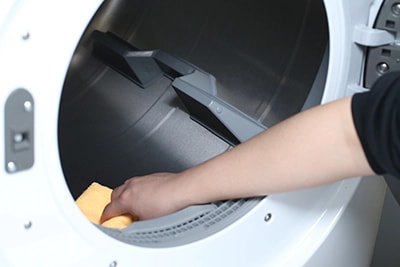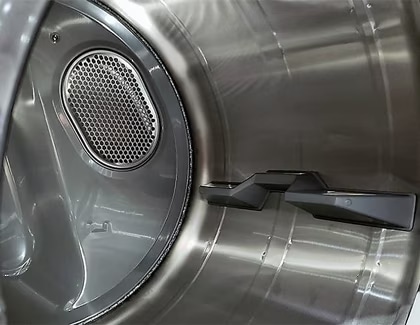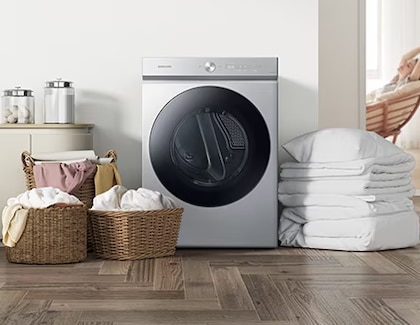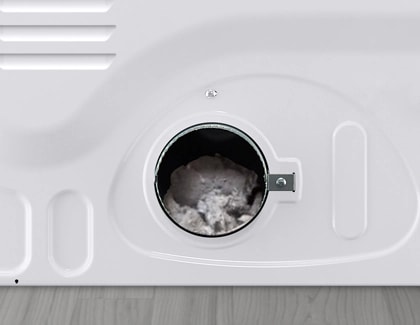How to clean your Samsung dryer

Dryers are one of the leading causes of house fires, and a very high percentage of dryer-related fires (over 9 out of 10) happen because they weren't kept clean. Keep your house safe and your energy costs low with a little routine maintenance. And if a crayon or some other kind of stain is all over your dryer, you'll want to clean that up before putting any more laundry in.
Note: The provided information refers to dryers sold in Canada.
Caution: To prevent fire risk, be sure to clean the lint filter before or after every load. Do not operate the dryer without the lint filter in place. Do not use a damaged or broken lint filter. This may reduce performance, cause a fire, or both.
Cleaning the lint filter is easy. Open the door, and then pull out the lint filter from inside the drum. Remove the lint that has accumulated inside the space. You can use a pipe cleaner to clear out the lint filter compartment. Clean the lint off the filter, reinsert the filter, and then close the door.

Given the choice between doing this before or after a cycle, we recommend before, since it will mean less lint for your dryer to deal with. But why not both? It never hurts to have as little lint as possible in your lint filter.
Note: If you need to replace your lint filter, visit our partner.
Sensor Dry cycles use the bars on the inside of the dryer drum that detect moisture, and stop the cycle when moisture is no longer detected. This is an easy way to run the cycle only as long (or as short) as needed to get the clothes dry, and save energy.
However, if you use dryer sheets frequently, a residue can build up on the sensor bars that prevents them from detecting moisture, so the dryer perpetually thinks the load is dry and ends cycles too soon. The bars may also get dirty and work less effectively.

Fortunately, the sensor bars can be easily cleaned with a soft cloth and mild soap, then dried off with a towel or other cloth.
Most of the time, you don't have to worry about moisture piling up in your dryer as long as you don't let wet clothes sit before starting the cycle. Wet or damp clothes can cause a mold or mildew smell to linger around the inside of the dryer, and you'll want to prevent that from happening.
Additionally, something might spill or stain your dryer (like a crayon or pen left in a pocket) so you may still need to clean your dryer's drum now and then.

If your dryer's drum is powder coated, you can remove stains from it with an all-purpose cleaner. Then, use some old towels or rags you don't care about and tumble them through a dry cycle. They'll collect the remaining stains or cleaner. Even if stains are left on your drum after that point, they won't get on your clothes anymore.
To clean a stainless steel drum, use a damp cloth with a mild, non-abrasive cleaner suitable for easily marred surfaces. Then, remove the cleaner residue and dry with a clean cloth.
You may want to clean the outside of your dryer and the control panel to remove any dust, lint, or fingerprints.
Always use a soft cloth when cleaning the control panel; you may dampen it if needed. Do not spray liquid cleaning agents or laundry stain removers directly onto the display, as they could cause damage. If you choose to use a liquid cleaner, make sure to apply a small amount onto the cloth first, and immediately wipe up any spills.

When cleaning the dryer’s exterior, use a soft, damp cloth and avoid using any abrasive products. Your dryer has a high-gloss finish that can be scratched by rough cleaners and sharp or heavy objects.
Here's the part people forget about. Over time, lint is going to clog up your exhaust vent. It just happens and there's not really a way to prevent it completely. This can affect drying performance and also cause house fires.
There are several do-it-yourself vent cleaners you can buy, but we recommend having a professional vent cleaning service come take care of it for you.
How often you'll need this will vary depending on how often you use your dryer and what kind of exhaust vent you have in your home. It can be anywhere from once every two years to twice a year. But it's way better to do it too often than not enough.

If you're reading this right now and you can't remember the last time you had your dryer's vent cleaned, then the time is now! Most of our dryers will reduce their heat when they detect the vent is clogged, so your clothes will take much longer to dry. Cleaning your vent will see a significant increase in your drying performance!
Note: A lot of our models have a vent blockage test that can confirm if your vent is either dirty or doesn't meet the requirements of the dryer.
Is this content helpful?
Thank you for your feedback!
Please answer all questions.

